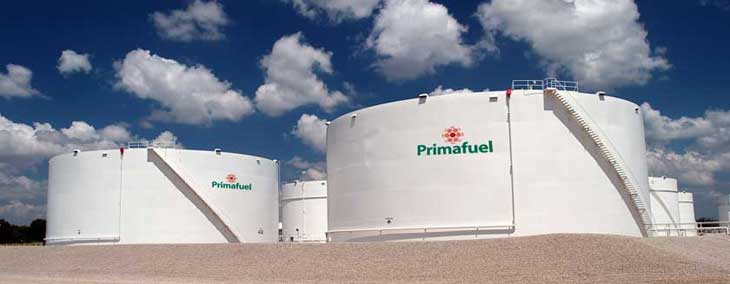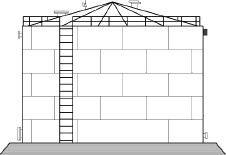 |
Tank Farm or Tank Terminal |
A Tank Farm is an industrial facility for the storage of oil, petroleum and petrochemical products, from which these products are transported to end users or other storage facilities.
A tank farm usually has a variety of above- or underground tanks, facilities for transfer between tanks, pumping facilities, loading portals for filling tankers or barges, loading and unloading equipment for ships at marine terminals and pipeline connections.
Location: Tank farms may be close to or part of oil refineries; they may also be located on the coast where ocean tankers can unload or load cargo. Some terminals are connected by pipelines from which they supply or discharge their products. Tank farms may also be served by rail, barge or tanker, and are also located near cities from which tankers transport products to gas stations or other domestic, commercial or industrial users.
 Tank Farm
Tank Farm
Facilities: In most tank farms, no on-site processing or other product transformation takes place. Refinery products stored at the terminal are suitable in their final form for delivery to customers. Products can be blended and additives can be injected into products, but there is usually no on-site production facility. Modern terminals have a high degree of site automation.
Some tank farms receive crude oil from offshore facilities. Crude oil entering through pipelines may be "spiked" with natural gas liquids (NGL) and is known as "live crude." Such oil must be processed or stabilized to remove the lighter fractions such as ethane, propane and butane to produce a dead or stabilized crude suitable for storage and transportation.
Such tank farms may include processing facilities to treat the oil to achieve a certain RVP (Reid Vapor Pressure). The process facilities include oil heaters to heat the oil, which is then piped to separator vessels. In the separators, the lighter fractions of the oil are separated and further processed to separate them into their individual components. The now stabilized oil can be stored and then sold or shipped for further processing.
Types of storage tanks
Industrial storage tanks are containers mainly used to store various substances such as gas, oil, water and petrochemical products. Agricultural tanks mainly store gas, oil, water and petrochemical products. They come in different sizes and shapes, including underground, horizontal and vertical configurations, and are made of materials such as concrete, stone, fiberglass, steel or plastic.
Above-ground tanks (AST) and underground tanks (UST) are the two main types of fuel storage tanks. ASTs are popular because of their low installation and maintenance costs, making them cost-effective and convenient for storing fuels and chemicals. USTs, on the other hand, bury at least 10% of their volume underground, making them suitable for space optimization and reducing the risk of explosions, but they must be registered and can present challenges in terms of inspection and potential leaks or contamination.
It is important to understand how regulations affect your tank farm operations. Whether you operate a chemical storage tank, operate a residential UST or own a farm, federal and state regulations apply.
| Tank Farm Design Guidelines | |
| Client-Specific Requirements | Clients may have unique operational needs or environmental considerations that must be addressed during the design phase, in addition to regulatory requirements. |
| Storage Tank Specifications | The choice of storage tanks is fundamental to tank farm design. Consider factors like tank size, material, and capacity to align with project needs and product properties. |
| Construction Material | Choosing the right material for tank construction is important to ensure structural integrity and prevent chemical reactions. Consider the storage properties, potential corrosion, and environmental conditions. |
| Plant Location's Topography | Understanding the plant location's geographical layout is essential for optimizing tank placement, foundation design, and overall feasibility. |
Related codes and standards
There are several codes and standards governing tank farm design in the United States..
- NFPA (National Fire Protection Association): Provides guidelines for fire protection and safety.
- OSHA (Occupational Safety and Health Administration): Focuses on worker safety and health.
- API Standard 2610: Covers design, construction, operation, maintenance and inspection of tank facilities.
- Local Safety Guidelines: Provides region-specific recommendations.
- State Factory Law (if applicable): Complies with state specific regulations.
- Fire hydrant instructions and spray manuals: Essential for fire protection.
- Insurance requirements: Specific to mitigate risk.
| API Standards for Storage Tanks | |
| API-620 | Design and Construction of Large, Welded, Low-Pressure Storage Tanks |
| API 650 | Welded Steel Tanks for Oil Storage |
| API-651 | Cathodic Protection for Above Ground Petroleum Storage Tanks |
| API-652 | Lining of Above Ground Petroleum Storage Tanks |
| API-653 | Tank Inspection, Repair, Alteration, and Reconstruction |
| API-2000 | Venting Atmospheric and Low-Pressure Storage Tanks |
| API-2015 | Cleaning Petroleum Storage Tanks |
| API-2517 | Evaporating Losses from External Floating Roof Tanks |
| API-2519 | Evaporating Losses from Internal Floating Roof Tanks |
| API-2350 | Overfill Protection for Petroleum Storage Tanks |
| API-2550 | Measurements and Calibration of Petroleum Storage Tanks |
Classification of petroleum products
Classification based on flammability (flash point) defines protocols for storage and handling..
- Class-A: Liquids with a flash point below 23°C.
- Class-B: Liquids with a flash point between 23°C and 65°C.
- Class-C: Liquids with a flash point between 65°C and 93°C.
- Excluded petroleum class: Liquids with a flash point of 93°C or higher.
Please note that specific regulations and classifications may vary by region or country. Thus, it is important to consult local regulations and standards when dealing with petroleum products in a particular jurisdiction.
References.. www.hm-ec.com | aspoenergy.com
Related Post(s)

Storage tanks containing organic liquids, non organic liquids, vapors and can be found in many industries. Most storage tanks are designed and built to the American Petroleum Institute API-650 specification...